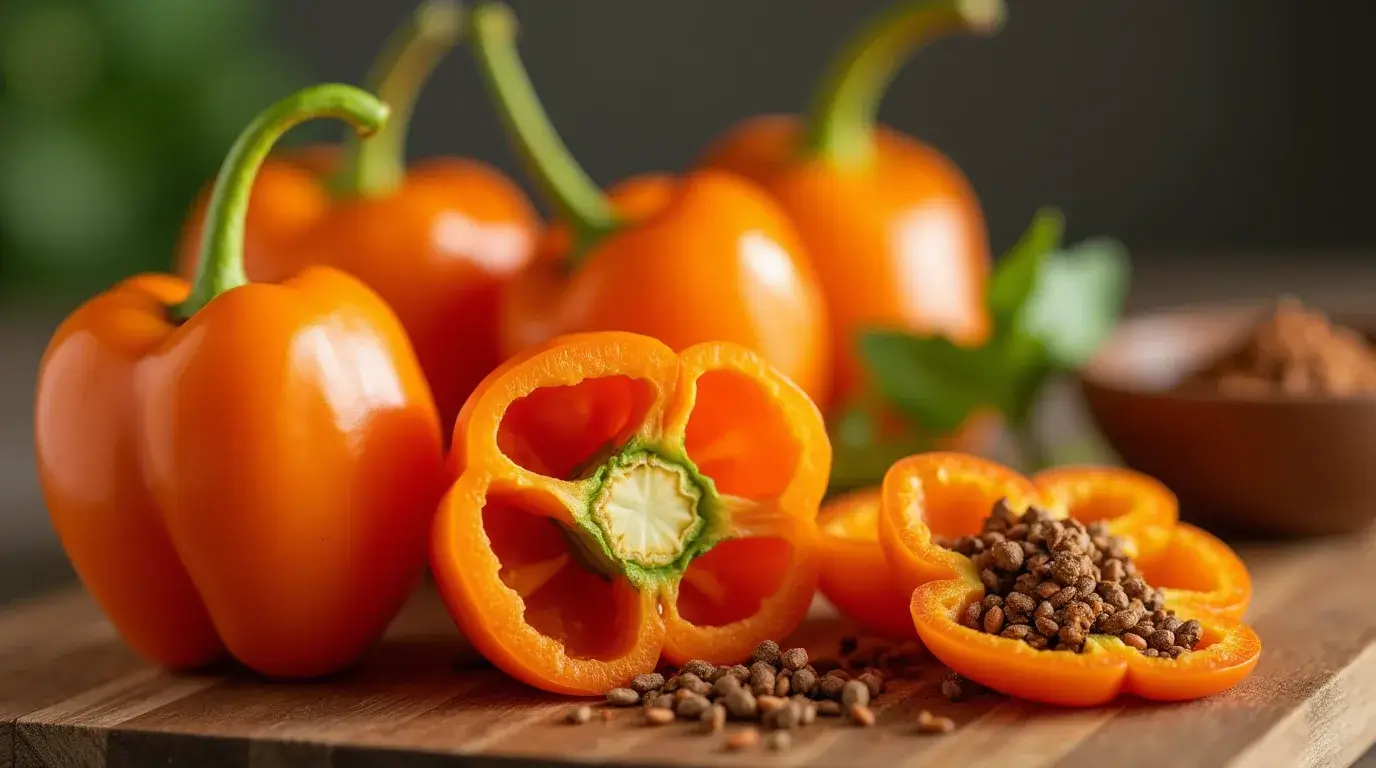Scotch bonnet peppers are a staple in many kitchens, especially in Caribbean cooking, known for their fiery heat and fruity flavor. But what happens when you can’t find them or need a milder option? Finding a scotch bonnet pepper substitute might seem tricky, but with the right choice, you can still achieve delicious results in your dishes.
In this article, we’ll explore the best alternatives to scotch bonnet peppers, including tips for matching their heat and unique taste. Whether you’re making jerk chicken, a spicy stew, or a homemade hot sauce, we’ve got you covered. Let’s dive into everything you need to know about substituting this iconic pepper without sacrificing flavor.
Understanding the Scotch Bonnet Pepper
What is a Scotch Bonnet Pepper?
The scotch bonnet pepper is a variety of chili pepper widely used in Caribbean and West African cuisines. It gets its name from its shape, which resembles a Scottish tam o’ shanter hat. Known for its intense heat and sweet, fruity flavor, this pepper packs a punch with a Scoville Heat Unit (SHU) rating of 100,000 to 350,000. This places it in the same heat range as habanero peppers, making it one of the hottest peppers commonly used in cooking.
Why Is It Unique?
What makes the scotch bonnet pepper stand out is its flavor. While many hot peppers focus solely on heat, the scotch bonnet adds a sweet, tropical note reminiscent of apricots or mangoes. This balance of sweetness and spice is why it’s a must-have in traditional dishes like jerk chicken and pepper sauces. Additionally, its vibrant color and aroma enhance both the presentation and taste of any recipe.
When and Why You Might Need a Substitute
Sometimes, finding a scotch bonnet pepper substitute becomes necessary due to availability issues or personal spice tolerance. These peppers aren’t always easy to locate outside regions where they’re commonly grown. Furthermore, their intense heat might be too much for some palates. In such cases, choosing the right substitute can help maintain the integrity of your dish while adapting to your needs.
Top Substitutes for Scotch Bonnet Pepper
Habanero Pepper: The Closest Match
When it comes to finding the perfect scotch bonnet pepper substitute, habanero peppers often take the top spot. Not only do they share a similar heat level—ranging between 100,000 and 350,000 SHU—but they also offer a comparable fruity flavor. Habaneros have a slightly sharper heat compared to scotch bonnets, but their sweet undertones make them an excellent match for Caribbean dishes like jerk chicken or spicy stews.
Pro Tip: If you’re using habaneros as a substitute, consider starting with a smaller amount. Their heat can build quickly, so taste and adjust as you go.

Jalapeño Pepper: A Mild Alternative
For those seeking a milder scotch bonnet pepper substitute, jalapeños are a great option. With a SHU rating between 2,500 and 8,000, jalapeños provide a gentle heat that’s more approachable for most palates. Although they lack the fruity sweetness of scotch bonnets, their crisp, grassy flavor works well in recipes where heat is just one part of the profile.
How to Use: Combine jalapeños with a touch of fruit juice, like mango or pineapple, to replicate the sweet notes of scotch bonnets. This can enhance the overall flavor while keeping the spice level manageable.
Thai Chili Peppers: Heat Without the Sweetness
Thai chili peppers, known for their bold heat and small size, are another viable scotch bonnet pepper substitute. These chilies bring an intense kick, with a SHU rating between 50,000 and 100,000, but they don’t have the same sweetness as scotch bonnets. They’re ideal for dishes where the heat is more important than the fruity flavor.
Best Uses: Add Thai chilies to soups, stir-fries, or sauces where spice takes center stage. Use them sparingly, as their heat can dominate quickly.
Cayenne Peppers: An Easy-to-Find Option
Cayenne peppers, whether fresh or in powder form, are a convenient alternative when you’re in a pinch. With a SHU range of 30,000 to 50,000, cayenne peppers offer moderate heat without overwhelming the dish. Although they don’t mimic the sweetness of scotch bonnets, their versatility makes them suitable for most recipes.
Quick Tip: To replicate some of the fruity flavors, mix cayenne pepper with a dash of sweet paprika or finely chopped bell peppers.
Bell Peppers with Spice Additions
If you’re cooking for someone sensitive to heat, bell peppers can be a creative scotch bonnet pepper substitute. While they lack heat entirely, their natural sweetness can mimic the fruity essence of scotch bonnets. Pair them with a pinch of chili powder or a few drops of hot sauce to add some spice.
How to Choose the Right Substitute
Factors to Consider
Choosing the right scotch bonnet pepper substitute depends on a few key factors, such as heat level, flavor profile, and the dish you’re preparing. For example, if you’re making a jerk marinade, you’ll need a pepper that brings both heat and sweetness, like a habanero. On the other hand, for soups or salsas, a milder option like jalapeños or cayenne might work better.
Important Tip: Always think about the role of the pepper in the dish. Is it meant to add flavor, spice, or both? This will guide your choice.
Matching Heat Levels
Understanding the Scoville Heat Unit (SHU) of different peppers is crucial when substituting for scotch bonnets. While habaneros match closely in heat, options like Thai chilies or cayenne peppers might require you to adjust the quantity. If you prefer a less spicy dish, start with smaller amounts and taste as you cook.
Heat Comparisons:
- Scotch Bonnet: 100,000–350,000 SHU
- Habanero: 100,000–350,000 SHU
- Jalapeño: 2,500–8,000 SHU
- Cayenne: 30,000–50,000 SHU
Adapting Recipes for Substitutes
When using a scotch bonnet pepper substitute, you may need to tweak your recipe slightly to maintain balance. For instance, if your substitute lacks sweetness, consider adding a bit of fruit juice or sugar. Similarly, if the heat isn’t strong enough, you can include additional spices like chili flakes or hot sauce.
Example: If you’re replacing scotch bonnets with bell peppers, add a pinch of cayenne and a teaspoon of pineapple juice to achieve a closer flavor match.
Using Substitutes in Specific Dishes
Jerk Chicken and Caribbean Recipes
Finding the right scotch bonnet pepper substitute is crucial for maintaining the authentic flavor of dishes like jerk chicken or other Caribbean specialties. Habanero peppers work exceptionally well here, as they offer both the heat and the fruity sweetness that scotch bonnets are known for. If you prefer a milder option, try using a mix of jalapeños and a splash of fruit juice, such as mango or pineapple, to replicate the sweetness.
For Caribbean stews, soups, and curries, cayenne peppers or Thai chili peppers can add the necessary heat while preserving the dish’s integrity. To enhance these substitutes, you can include ingredients like allspice and fresh thyme, which are traditional to Caribbean cuisine.

Suggestion for Further Reading: For more creative ways to enhance your dishes, check out “Hot Sauce Making Kit”.
Soups, Stews, and Curries
When using a scotch bonnet pepper substitute in soups and stews, focus on balancing the heat and flavor. Habaneros are the best match here, as their fruity notes elevate rich, hearty dishes. Alternatively, cayenne pepper or even red pepper flakes can provide spice, but you may need to add sweetness to mimic the scotch bonnet’s unique profile.
For curries, Thai chili peppers shine. They offer a sharp heat that pairs well with the creamy, aromatic bases of coconut milk or yogurt, often found in curry recipes.
Salsas and Hot Sauces
Making salsa or hot sauce with a scotch bonnet pepper substitute requires careful ingredient adjustments. For salsa, jalapeños paired with ripe mangoes can replicate both the heat and sweetness of scotch bonnets. In hot sauces, combining habanero peppers with red bell peppers adds depth while softening the spiciness.
FAQs About Scotch Bonnet Pepper Substitutes
What Pepper Can I Use Instead of Scotch Bonnet?
The best pepper to use instead of a scotch bonnet is the habanero pepper. Both have a similar heat level and fruity flavor, making habaneros an excellent match in most recipes. If you’re looking for a milder option, jalapeños or cayenne peppers can work, though you may need to add a touch of sweetness to replicate the unique flavor profile of a scotch bonnet.
What Is a Substitute for Scotch Bonnet in Jerk Chicken?
For jerk chicken, the ideal substitute for scotch bonnet is also the habanero pepper, as it closely mimics the heat and fruity notes essential for authentic jerk seasoning. If you need a milder option, try jalapeños mixed with a bit of fruit juice (like mango or pineapple) to balance the flavors. For a smokier twist, Thai chili peppers or cayenne pepper can also work, though they lack the sweetness of scotch bonnets.
What Is the Same as a Scotch Bonnet?
While nothing is exactly the same as a scotch bonnet, the habanero pepper is its closest match in terms of heat and flavor. Both peppers belong to the same species (Capsicum chinense) and have a similar Scoville Heat Unit (SHU) range of 100,000–350,000, as well as a fruity undertone. However, scotch bonnets are slightly sweeter and have a more tropical taste.
Is Scotch Bonnet the Hottest Pepper?
No, the scotch bonnet is not the hottest pepper. While it is very spicy, with a SHU range of 100,000–350,000, it is far surpassed by peppers like the Carolina Reaper (up to 2.2 million SHU) and the Ghost Pepper (up to 1 million SHU). The scotch bonnet’s heat is intense but manageable, especially when balanced with its sweet, fruity flavor.
Suggestion for Further Reading: For more inspiration, explore “The Ultimate Guide to Banana Chocolate Cake” for creative uses of sweet ingredients.
Conclusion and Final Tips
Why Substitutes Are Essential
Finding the right scotch bonnet pepper substitute is more than just a matter of convenience—it’s about keeping the spirit of your dish alive. Whether you’re making a traditional Caribbean recipe, a fiery hot sauce, or a bold stew, using a suitable replacement ensures your dish still delivers on flavor and spice. Substitutes like habaneros, jalapeños, and cayenne peppers provide a range of options that cater to different heat levels and flavor preferences.
Additionally, having substitutes on hand allows you to experiment with new flavors while respecting dietary or availability constraints. The key is understanding the role of the pepper in your dish—whether it’s for heat, sweetness, or a balance of both.
Encouragement to Experiment
Don’t be afraid to get creative when choosing a scotch bonnet pepper substitute. Cooking is as much about experimenting as it is about following recipes. Adjusting spice levels, combining different peppers, or even adding unique ingredients like fruit juice can open up a world of flavor possibilities.

Remember, substitutions aren’t about making an exact copy—they’re about adapting to what you have while still achieving delicious results. With the right approach, you’ll never feel limited in your kitchen again.

